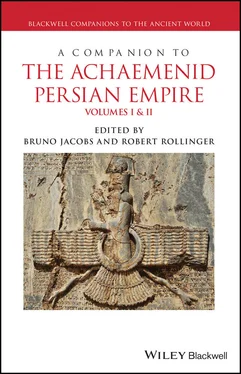bCf. my attempt to interpret the seal of Erimena, and the chronological problems concerning the seventh century BCE: Salvini 2007.
cWe have to take into consideration the new dendrochronology following which Rusa  inili Eidurukai (Ayanis) was built in the second half of the 670s BCE: Manning et al. 2001, p. 2534; Çilingirog˘lu 2006, 135.
inili Eidurukai (Ayanis) was built in the second half of the 670s BCE: Manning et al. 2001, p. 2534; Çilingirog˘lu 2006, 135.
Last Records on Urar  u
u
Nabopolassar (625–605 BCE): pīāt KURUrašṭu (years 608, 607 BCE)
Sedekias, King of Juda (568–587 BCE):’rrt (year 594 BCE)
Nabonidus Chronicle 7, 15–18 (year 547 BCE): ⌈Ú⌉‐[raš‐ṭu (Cyrus II)
Babylonian sources of the sixth century: LÚUraštaja (nisbe)
Babylonian Map of the World: Urašṭu
Darius I (521–486 BCE), Bisutun: Urašṭu/Armina
Xerxes (485–464 BCE): Urašṭu/Armina
Darius II (424–404 BCE): Urašṭu
Artaxerxes II (404–359 BCE) or III (359–358 BCE) (Persepolis): Arminiya
1 André‐Salvini, B., Salvini, M. (1992). Gli annali di Argišti I, note e collazioni. Studi Micenei ed Egeo‐Anatolici, 30, pp. 9–23.
2 Baker, H.T. (2000). The Prosopography of the Neo‐Assyrian Empire, Vol. 2, Part I, ‐K. Helsinki: The Neo‐Assyrian Text Corpus Project.
3 Burney, C.A. (1971). Excavations at Haftavan Tepe 1971: third preliminary report. Iran, 11, pp. 153–172.
4 Calmeyer, P. (1975). Zur Genese altiranischer Motive III. Felsgräber. Archaeologische Mitteilungen aus Iran, Neue Folge, 8, pp. 99–113.
5 Çilingirog˘lu, A. (2006). An Urartian fortress in front of Mount Eiduru: Ayanis. Aramazd: Armenian Journal of Near Eastern Studies, 1, pp. 135–142.
6 Çilingirog˘lu, A., Salvini, M. (eds.) (2001). Ayanis I. Ten Years' Excavations in Rusahinili Eiduru‐kai (Documenta Asiana 6). Roma: Istituto di Studi sulle Civiltà dell’Egeo e del Vicino Oriente.
7 Dyson, R.H. (1989). Rediscovering Hasanlu. Expedition, 31/2–3, pp. 3–11.
8 Fuchs, A. (2012). Urarṭu in der Zeit. In S. Kroll, C. Gruber, U. Hellwag, M. Roaf, and P. Zimansky (eds.), Biainili‐Uraru, The Proceedings of the Symposium Held in Munich 12–14 October 2007 (Acta Iranica 51). Louvain: Peeters, pp. 135–161.
9 Kleiss, W., Kroll, S. (1980). Die Burgen von Libliuni (Seqindel). Archaeologische Mitteilungen aus Iran: Neue Folge, 13, pp. 21–61.
10 Lanfranchi, G.B., Parpola, S. (1990). The Correspondence of Sargon II, Part II: Letters from the Northern and Northeastern Provinces (State Archives of Assyria V). Helsinki: Helsinki University Press.
11 Lehmann‐Haupt, C.F. (1926). Armenien einst und jetzt II/1. Berlin, Leipzig: Behr's Verlag.
12 Malbran‐Labat, F. (1994). La version akkadienne de l’inscription trilingue de Darius à Behistun (Documenta Asiana I). Roma: Gruppo Editoriale Internazionale.
13 Manning, S., Kromer, B., Kuniholm, P.I., Newton, M.W. (2001). Anatolian tree rings and a new chronology for the east Mediterranean Bronze‐Iron Ages. Science, 21, Vol. 294, Issue 5551, pp. 2532–2535.
14 Marr, N., Orbeli, I. (1922). Archeologičeskaja ekspedicija 1916 goda v Van: Raskopki dvuch niš na Vanskoj Skale i nadpisi Sardura vtorogo iz raskopok zapadnoj niši. St. Petersburg: Akedemičeskaja Tipografija.
15 RlA = Reallexikon des Assyriologie und Vorderasiatischen Archäologie, 18 volumes (1922–2018). Berlin/New York: de Gruyter.
16 Muscarella, O.W. (2012). Hasanlu and Urartu. In Kroll, S., Gruber, C., Hellwag, U., Roaf, M., and Zimanski, P. (eds.), Biainili‐Uraru, The Proceedings of the Symposium Held in Munich 12–14 October 2007 (Acta Iranica 51). Louvain: Peeters, pp. 205–279.
17 Pecorella, P.E., Salvini, M. (1984). Tra lo Zagros e l’Urmia: Ricerche storiche ed archeologiche nell’Azerbaigian iraniano. Roma: Edizioni dell’Ateneo.
18 Rollinger, R. (2009). The Median ‘Empire’ and Cyrus the great's campaign in 547 BC (Nabonidus Chronicle II 6). Ancient West and East, 7, pp. 49–63.
19 Salvini, M. (1993). s.v. Mešta, Reallexikon der Assyriologie, 8, 1/2, p. 95.
20 Salvini, M. (1995). Geschichte und Kultur der Urartäer. Wiesbaden: Wissenschaftliche Buchgesellschaft.
21 Salvini, M. (ed.) (2000). La civiltà dei Hurriti (La Parola del Passato 55). Napoli: Gaetano Macchiaroli Editore, pp. 7–24.
22 Salvini, M. (2007). Argišti, Rusa, Erimena, Rusa und die Löwenschwänze: Eine urartäische Palastgeschichte des VII. Jh. v. Chr. Aramazd: Armenian Journal of Near Eastern Studies, 2, pp. 146–162.
23 Salvini, M. (2009). The eastern provinces of Urartu and the beginning of history in Iranian Azerbaijan. In H. Sag˘lamtimur, E. Abay, Z. Derin, et al. (eds.), Studies in Honour of Altan Çilingirog˘lu: A Life Dedicated to Urartu on the Shores of the Upper Sea. Istanbul: Arkeoloji ve Sanat Yayınları, pp. 581–598.
24 Salvini, M. (2018). s.v. aldi, Reallexikon der Assyriologie, 15, 7/8, pp. 378‐380.
25 Schmitt, R. (2009). Die altpersischen Inschriften der Achaimeniden: Editio minor mit deutscher Übersetzung. Wiesbaden: Dr. Ludwig Reichert Verlag.
26 Schulz, F.E. (1840). Mémoire sur le lac de Van et ses environs. Journal Asiatique: série III, 9, pp. 257–323 (envoyé à Paris le 8 juin 1828), 1840.
27 Seidl, U. (1994). Achaimenidische Entlehnungen aus der urartäischen Kultur. In H. Sancisi‐Weerdenburg, A. Kuhrt, and M. Cool Root (eds.), Continuity and Change (Achaemenid History 8). Ann Arbor, Michigan/Leiden: Nederlands Instituut voor het Nabije Oosten, pp. 107–129.
28 Seidl, U. (2004). Bronzekunst Urartus, Mainz: von Zabern.
29 Seidl, U. (2007). Wer gründete Rusainili/Toprakkale? Aramazd: Armenian Journal of Near Eastern Studies, 2, pp. 137–145.
30 Stronach, D. (1967). Urartian and Achaemenian tower temples. Journal of Near Eastern Studies, 26, pp. 278–288.
31 Stronach, D. (2012). Urartian impact on Achaemenid and pre‐Achemenid architecture in Iran. In S. Kroll, C. Gruber, U. Hellwag, M. Roaf, and P. Zimanski (eds.), Biainili‐Uraru, The Proceedings of the Symposium held in Munich 12–14 October 2007 (Acta Iranica 51). Louvain: Peeters, pp. 309–320.
32 Tadmor, H. (1994). The Inscriptions of Tiglath‐pileser III King of Assyria. Jerusalem: The Israel Academy of Sciences and Humanities.
33 Thureau‐Dangin, F. (1912). Une relation de la huitième campagne de Sargon (714 av. J.‐C.) (Textes cunéiformes du Louvre 3). Paris: Librairie Orientaliste Paul Geuthner.
34 Wilhelm, G. (1986). Urartu als Region der Keilschrift‐Kultur. In V. Haas (ed.), Das Reich Urartu. Konstanz: Universitätsverlag Konstanz, pp. 95–116.
35 Zimansky, P.E. (1998). Ancient Ararat: A Handbook of Urartian Studies. New York: Caravan Books Delmar.
1 Biainili‐Urarṭu (2012). The Proceedings of the Symposium Held in Munich 12–14 October 2007/Tagungsbericht des Münchener Symposiums 12.–14. Oktober 2007 (Ed. By S. Kroll, C. Gruber, U. Hellwag, M. Roaf, and P. Zimansky) (Acta Iranica 51). Louvain: Peeters. A transdisciplinary and up‐to‐date discussion of Urartian history.
2 Haas, V. (ed.) (1986). Das Reich Urartu. Konstanz: Universitätsverlag Konstanz. Contributions about some aspects of the Urartian history and culture.
3 Kroll, S., Gruber, C., Hellwag, U., Roaf, M., and Zimanski, P. (eds.) (2012). The Proceedings of the Symposium Held in Munich 12–14 October 2007 (Acta Iranica 51). Louvain: Peeters. The most recent and richest analysis of aspects of the Urartian civilization, provided by many of the best Orientalists: historians, philologists, and archaeologists. Bibliography is the most complete and up to date.
Читать дальше

 inili Eidurukai (Ayanis) was built in the second half of the 670s BCE: Manning et al. 2001, p. 2534; Çilingirog˘lu 2006, 135.
inili Eidurukai (Ayanis) was built in the second half of the 670s BCE: Manning et al. 2001, p. 2534; Çilingirog˘lu 2006, 135. u
u










